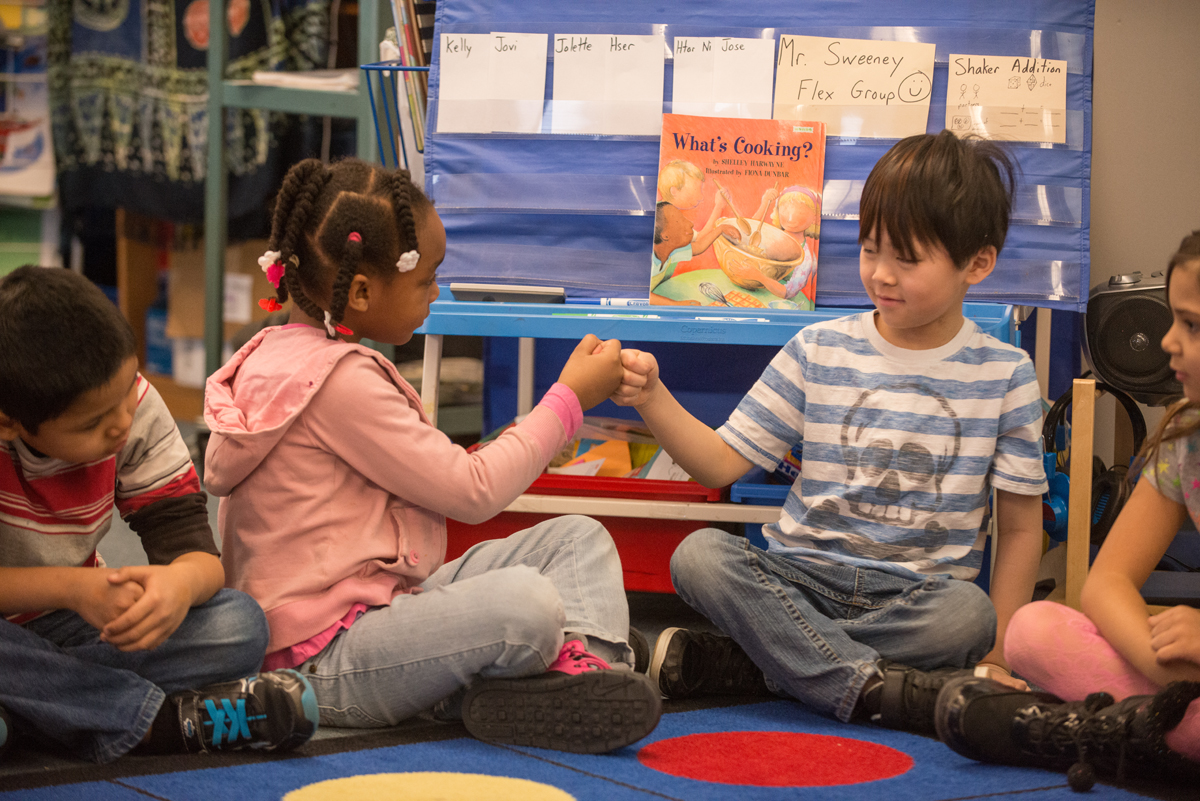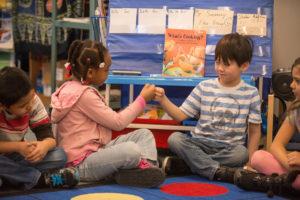Our Hopes and Dreams for School

 “What are your hopes and dreams for the school year?”
“What are your hopes and dreams for the school year?”
Many teachers ask this question in the first weeks of school to help students get excited about learning and make a personal connection to what they will learn in school. Inviting students to name learning goals (hopes and dreams) right away shows them that school is a safe place, that they’re important members of the classroom, and that they can look forward to an engaging, challenging, and fun year of learning. Establishing this classroom tone is one of the most important things to do at the beginning of the year.
The process of articulating hopes and dreams varies depending on the students’ grade level and the teacher’s style. Below are ideas for various grade ranges and special area teachers.
Grades K–2
Young students often need some school experience before they can start thinking about what they want to learn and do in school. Allow students to familiarize themselves with the new routine of school for the first couple days (or first week for kindergartners and first graders) before you help them establish learning goals.
After that initial settling-in period, invite the children to think about their hopes and dreams. Here’s one approach to doing this with these young students:
- Ask students, “Why do we come to school?” If they give a broad answer such as “to learn,” help them stretch their thinking: “What can we learn in school?” Write down their ideas. They might say “To do things like write,” “I think we will learn science stuff,” or “To make friends.”
- The next day, ask students to reflect on their list of reasons for coming to school, and then help them think about specific learning goals. To guide them, say, “Today we’re going to make another list. What are some of your hopes and dreams for the year?” Give examples of your own hopes and dreams, such as “This year, I hope our classroom will be a place where all of you find enjoyment and get to work at things that really matter to you.” With this guidance, even students this young can turn a vague statement about why people come to school, such as “To do things like write,” into a realistic learning goal: “I want to learn to write a story.”
- Over the next few days, continue to list students’ ideas as they share. Keep each brainstorming session short, about five to ten minutes. Stretching this process over several days gives ideas a chance to percolate and sends the message that sorting out learning goals is important work, not something to rush.
- If any goals seem unrealistic, coach students in rethinking. For example, if a student says “I want to read all the books in the library,” you can respond with “Sounds like you want to do a lot of reading this year. Can I write that down as your goal?”
- By the following week, everyone should be ready to choose one learning goal that’s most important to them. Have students write down and illustrate that goal (with help from you and other adults in the room as needed).
- By the end of that week, students can share their learning goal with the class. Post students’ hopes and dreams on the classroom bulletin board for all to see.
Grades 3–4
To help students get enthusiastic about school right away, invite them to begin thinking about their hopes and dreams early in the first week of school. The challenge is to help them set learning goals that they truly care about and can realistically achieve in school this year. Here’s one way to do this:
- At the end of the first day, introduce students to learning goals in closing circle—a daily gathering before dismissal that helps students end the day on a positive note and feel energized about their learning. Going around the circle, ask students, “What’s one thing you enjoyed about your first day of school?” and “What’s something you’re looking forward to tomorrow?” Then ask students to spend a few minutes that night thinking about what they want to learn and do in school this year.
- Over the next couple days, help students brainstorm learning goals in short sessions, spreading this brainstorming over the course of the week to give them time to come up with lots of ideas. You might want to have students use a worksheet to help them come up with a goal that’s achievable and meaningful. Start off the first session by sharing your own hopes and dreams. For example, you might say, “I hope our class grows into a safe and strong learning community.”
- Coach students who list goals that may be too broad or unrealistic for the school year. For example, if a student says “I want to be a professional musician,” discuss the skills and habits needed to reach such a long-term goal and choose one that’s realistic to focus on this year. For example, musicians need stick-to-itiveness, and an attainable school-year goal related to that might be “to keep trying even when something is difficult.”
- By the end of the first week, students should be ready to choose one goal to illustrate and share with the class. Display everyone’s hopes and dreams on the classroom bulletin board for all to see.
Grades 5–6
Students in grades 5 and 6 are ready to set realistic, meaningful learning goals right from the start of school. Students this age are also ready for the additional challenge of stating one goal having to do with academic learning and one having to do with social relationships. Here’s one way to help them do this:
- On the second day of school, introduce students to learning goals in the Morning Meeting message, such as “This week we will think about our learning goals. What are some of your hopes and dreams for this school year? Try to think of both what you want to learn in different subjects and how you want to work with others.” To guide students, state your own hopes and dreams. Be sure you also touch on both academic and social learning in your statement. For example, you might include in the message “I really hope everyone will feel safe, take care of each other, and be thinking workers.”
- Have a brief coaching conference with students who list goals that are too broad or unrealistic. For example, if a student says “I hope I get to play video games all day,” you can help turn it into an attainable goal such as “to learn all that I can about computers this year.”
- By the end of the first week (or beginning of the second week), ask students to choose one social and one academic learning goal that is most important to them to write down and illustrate. Display everyone’s hopes and dreams on the classroom bulletin board and give the class time to read what classmates have shared.
Special Area Teachers
Like other teachers, special area teachers can have students name learning goals for the year. This step establishes a sense of purpose and anticipation for the work students will do in the special area room.
- Start by articulating your own hopes and dreams for this year. For example, you might say, “This year, I hope that we have the kind of [special area] classroom where students can be really creative, take some risks, and try new skills. I hope you all enjoy [special area] and look forward to coming each week.”
- Next, prompt students to think about their own learning goals by saying, “Now think about your hopes and dreams for this year in [special area]. What are some of your goals? What are some things you might like to learn?”
Special area teachers find many different ways for students to share their hopes and dreams. For example:
- One physical education teacher has each student write their learning goal for PE on a paper basketball, which they then display on the “Hoops and Dreams” wall.
- A music teacher fills his room with pictures of children playing an instrument, dancing, singing, or engaging in various other musical pursuits—students’ illustrations of their musical hopes and dreams for the year.
Supporting a Key Goal of the First Weeks of School
One of our most important goals in the first weeks of school is to help students trust that school will be a place where their ideas matter and where the learning is meaningful. Guiding them in naming their learning goals for the year is a powerful way to meet this goal. Time spent on this activity is an investment that reaps benefits for months to come.
A Prelude to Rules
Besides setting a tone of purposeful learning, inviting students to articulate their learning goals for the year is also an important first step in co-creating classroom rules with students.
For example, after students share their goals with the class, you might say, “You’ve had a chance to read everyone’s hopes and dreams. Let’s start thinking of some rules that can help us work together really well and allow everyone to reach their goals.” Next you would consolidate the ideas students name into a manageable list that will serve as the classroom rules for the year.
Even if you’re planning to use existing rules—ones shared by your team, grade level, or whole school—you’ll still want to ask students to articulate their hopes and dreams so you can talk with them about how these rules enable them to achieve their goals. When you connect students’ goals to the rules like this, no matter where the rules come from, you help students see rules as positive guidelines that create a safe, supportive classroom in which they can do their best learning.
Learn More About the First Weeks of School
Creating learning goals is just one strategy for making the early weeks of school a highly fruitful time of year. To learn many others, see The First Six Weeks of School, 2nd edition. You’ll find practical ideas that enable you to:
- Create a climate of warmth, inclusion, and safety.
- Teach classroom routines and behavior expectations.
- Help students get to know and care for the classroom and school environment.
- Establish expectations for academic work.
For more information on learning goals, how they connect to classroom rules, and other important strategies for a successful beginning to the school year, you can also check out Rules in School: Teaching Discipline in the Responsive Classroom.
(an adapted excerpt from The First Six Weeks of School, 2nd edition)
Tags: First Day of School, Hopes and Dreams/Learning Goals, Special Areas